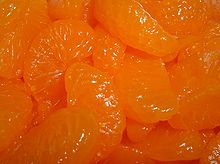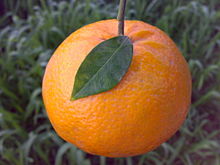
The Mandarin orange, also known as the mandarin or mandarine (both lower-case), is a small citrus tree (Citrus reticulata) with fruit resembling other oranges. Mandarin oranges are usually eaten plain or in fruit salads. Specifically reddish-orange mandarin cultivars can be marketed as tangerines, but this is not a botanical classification. When exporting began, local Mandarin oranges were named after their port of origin.[1]
The tree is more drought-tolerant than the fruit. The mandarin is tender, and is damaged easily by cold. It can be grown in tropical and subtropical areas.
Varieties
The mandarin orange is a variety of the orange family. Cultivars and crosses between the original mandarin and other citrus fruits include:
- Satsuma (Citrus unshiu), a seedless variety, of which there are over 200 cultivars, such as Owari and mikan; the source of most canned mandarins, and popular as a fresh fruit due to its ease of consumption
- Owari, a well-known Satsuma cultivar which ripens during the late fall season
- Clementine, sometimes known as a "Christmas orange", as its peak season is Winter; becoming the most important commercial Mandarin orange form, having displaced mikans in many markets
- Tangerine sometimes known as "Dancy Mandarin"
- Tangor, also called the temple orange, a cross between the Mandarin orange and the common sweet orange; its thick rind is easy to peel and its bright orange pulp is sour-sweet and full-flavored
The mandarin is easily peeled with the fingers, starting at the thick rind covering the depression at the top of the fruit, and can be easily split into even segments without squirting juice. This makes it convenient to eat, as utensils are not required to peel or cut the fruit.
Canned mandarin segments are peeled to remove the white pith prior to canning; otherwise, they turn bitter. Segments are peeled using a chemical process. First, the segments are scalded in hot water to loosen the skin; then they are bathed in a lye solution which digests the albedo and membranes. Finally, the segments undergo several rinses in plain water.



No comments:
Post a Comment